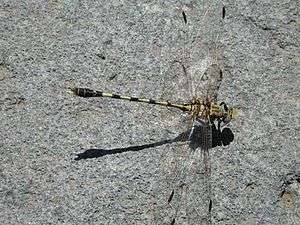Progomphus
Progomphus is a genus of medium-sized dragonflies in the family Gomphidae. They are found in the Americas and are largely tropical.[1] They are one of the few Gomphids with coloured wings.
| Progomphus | |
|---|---|
 | |
| P. borealis | |
| Scientific classification | |
| Kingdom: | |
| Phylum: | |
| Class: | |
| Order: | |
| Family: | |
| Genus: | Progomphus Selys, 1854 |
They are commonly called sanddragons. They are usually found on freshwater sandy beaches and pools.[1]
The genus contains the following species:[2][3]
- Progomphus abbreviatus Belle, 1973
- Progomphus aberrans Belle, 1973
- Progomphus adaptatus Belle, 1973
- Progomphus alachuensis Byers, 1939 – tawny sanddragon[4]
- Progomphus amarillus Tennessen, 1992
- Progomphus amazonicus Belle, 1973
- Progomphus angeloi Belle, 1994
- Progomphus anomalus Belle, 1973
- Progomphus approximatus Belle, 1966
- Progomphus auropictus Ris, 1911
- Progomphus australis Belle, 1973
- Progomphus basalis Belle, 1994
- Progomphus basistictus Ris, 1911
- Progomphus bellei Knopf & Tennessen, 1980 – Belle's sanddragon[4]
- Progomphus belyshevi Belle, 1991
- Progomphus bidentatus Belle, 1994
- Progomphus boliviensis Belle, 1973 – Bolivian sanddragon[5]
- Progomphus borealis McLachlan in Selys, 1873 – gray sanddragon[4]
- Progomphus brachycnemis Needham, 1944
- Progomphus clendoni Calvert, 1905
- Progomphus complicatus Selys, 1854
- Progomphus conjectus Belle, 1966
- Progomphus costalis Hagen in Selys, 1854
- Progomphus delicatus Belle, 1973
- Progomphus dorsopallidus Byers, 1934
- Progomphus elegans Belle, 1973
- Progomphus fassli Belle, 1973
- Progomphus flinti Belle, 1975
- Progomphus formalis Belle, 1973
- Progomphus geijskesi Needham, 1944
- Progomphus gracilis Hagen in Selys, 1854
- Progomphus guyanensis Belle, 1966
- Progomphus herrerae Needham & Etcheverry, 1956
- Progomphus incurvatus Belle, 1973
- Progomphus integer Hagen in Selys, 1878
- Progomphus intricatus Hagen in Selys, 1858
- Progomphus joergenseni Ris, 1908
- Progomphus kimminsi Belle, 1973
- Progomphus lambertoi Novelo-Gutiérrez, 2007
- Progomphus lepidus Ris, 1911
- Progomphus longistigma Ris, 1918
- Progomphus maculatus Belle, 1984
- Progomphus marcelae Novelo-Gutiérrez, 2007
- Progomphus mexicanus Belle, 1973
- Progomphus microcephalus Belle, 1994
- Progomphus montanus Belle, 1973
- Progomphus nervis Belle, 1973
- Progomphus nigellus Belle, 1990
- Progomphus obscurus (Rambur, 1842) – common sanddragon[4]
- Progomphus occidentalis Belle, 1983
- Progomphus perithemoides Belle, 1980
- Progomphus perpusillus Ris, 1918
- Progomphus phyllochromus Ris, 1918
- Progomphus pijpersi Belle, 1966
- Progomphus polygonus Selys, 1879
- Progomphus pygmaeus Selys, 1873
- Progomphus racenisi De Marmels, 1983
- Progomphus recticarinatus Calvert, 1909
- Progomphus recurvatus Ris, 1911
- Progomphus risi Williamson, 1920 – Ris's sanddragon[6]
- Progomphus serenus Hagen in Selys, 1878 – Hispaniolan sanddragon[7]
- Progomphus superbus Belle, 1973
- Progomphus tantillus Belle, 1973
- Progomphus tennesseni Daigle, 1996 – bristle-tipped sanddragon[8]
- Progomphus tibialis Belle, 1973
- Progomphus victor St. Quentin, 1973
- Progomphus virginiae Belle, 1973
- Progomphus zephyrus Needham, 1941 – elusive sanddragon[9]
- Progomphus zonatus Hagen in Selys, 1854
References
- Paulson, Dennis. Dragonflies and damselflies of the East. Princeton, N.J.: Princeton University Press. ISBN 9780691122830.
- Martin Schorr; Dennis Paulson. "World Odonata List". University of Puget Sound. Retrieved 12 Oct 2018.
- Progomphus, Animal Diversity
- "North American Odonata". University of Puget Sound. Retrieved 23 August 2013.
- von Ellenrieder, N. (2009). "Progomphus boliviensis". IUCN Red List of Threatened Species. 2009. Retrieved 23 August 2013.CS1 maint: ref=harv (link)
- Paulson, D. & von Ellenrieder, N. (2006). "Progomphus risi". IUCN Red List of Threatened Species. 2006: e.T18337A8101209. doi:10.2305/IUCN.UK.2006.RLTS.T18337A8101209.en. Retrieved 24 December 2017.
- Paulson, D. & von Ellenrieder, N. (2006). "Progomphus serenus". IUCN Red List of Threatened Species. 2006: e.T59761A11978419. doi:10.2305/IUCN.UK.2006.RLTS.T59761A11978419.en. Retrieved 24 December 2017.
- Paulson, D. & von Ellenrieder, N. (2006). "Progomphus tennesseni". IUCN Red List of Threatened Species. 2006: e.T59762A11979399. doi:10.2305/IUCN.UK.2006.RLTS.T59762A11979399.en. Retrieved 24 December 2017.
- Paulson, D. & von Ellenrieder, N. (2006). "Progomphus zephyrus". IUCN Red List of Threatened Species. 2006: e.T60262A12318201. doi:10.2305/IUCN.UK.2006.RLTS.T60262A12318201.en. Retrieved 24 December 2017.
- Dunkle, S.W., Dragonflies through Binoculars. Toronto:Oxford University Press, 2000.
- Progomphus, The Odonata - Dragonflies and Damselflies
- Progomphus, BugGuide
This article is issued from Wikipedia. The text is licensed under Creative Commons - Attribution - Sharealike. Additional terms may apply for the media files.